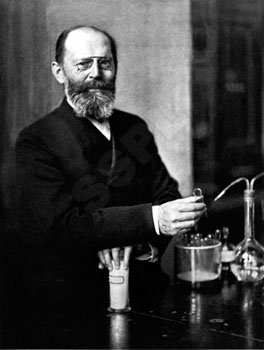Emil Fischer
(1852 - 1919)


Berlin chemist Emil Fischer and Joseph von Mering synthesized diethyl barbituric acid or barbitone (Veronal) in 1902. They described their discovery in “Ueber eine neue Klasse von Schlafmitteln”, Therap Gegenw 44:97-101, 1903. The parent compound, barbituric acid, was first synthesised by Adolf von Baeyer in 1864, but barbituric acid is not itself pharmacologically active.Fischer and von Mering soon realised that their new drug was a sedative. Veronal represented a huge improvement on the medley of existing agents. It didn't taste unpleasant. It had few adverse side effects. Unlike foul-tasting potassium bromide, Veronal acted at therapeutic levels far beneath the toxic dose. Some 2,500 barbiturates were synthesized over the next century. More than fifty have been marketed as sedatives. In 1912, phenobarbital was introduced under the brand-name Luminal. From 1912 until around 1960 barbiturates were the mainstay of pharmacological treatments of anxiety and insomnia. The development of soluble barbiturates suitable for use as intravenous anaesthetics still lay in the future. German pharmacologist Helmut Weese (1897-1954) described the use of the ultra-short-acting hexobarbital (Evipan) as an induction agent on several thousand patients in 1932.
A notable class of barbiturate derivatives is the thiobarbiturates. most famously sodium pentothal / sodium thiopental / thiopental (or thiopentone) sodium. It is used as an intravenous anaesthetic. Recovery is rapid and side-effects are minimal. It is a short-acting, highly lipid-soluble drug that induces brief general anaesthesia lasting 10 - 30 minutes by depression of central nervous system within a minute or so of injection. Since the analgesia induced at sub-anaesthetic doses is minimal, thiopental is used alone only for brief procedures. More commonly, thiopental is used to induce hypnosis and anaesthesia prior to the use of other anaesthetic agents.
Pentothal is one of a number of short-acting barbitrates known (misleadingly) as a "truth serum". No such agent (yet) exists, though its use continues among intelligence agencies. The pentothal-facilitated interrogation of al-Qaida operative Abu Zubaydah allegedly revealed collusion between high-ranking Saudi royals and al-Qaida.
Thiopental was discovered in the 1930s by Ernest H. Volwiler and Donalee L. Tabern, working for Abbott Laboratories. Its use was popularised in anaesthesiology by John Lundy, working at the Mayo Clinic. It is still in use today. The use of barbiturates in psychiatric medicine was superseded by the benzodiazepines, which are safer in overdose.
HOME
Search
Resources
Snapshots
Utopian Surgery
Refs and Further Reading
Anaesthesia and Anaesthetics